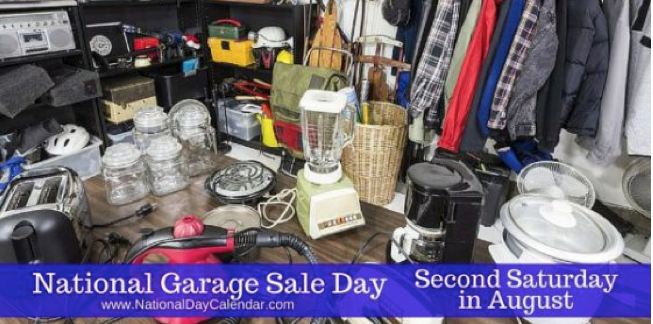The Zen of Garage Sales
Two veteran garage sale organizers share a detailed list for a successful - and profitable - event!
- story by Susan McManus and Christina Richardson
There has even been a National Garage Sale Day since 2001.
These sales can be very modest. It can be just a family or two, or an event with multiple providers of stuff. Size matters to some. This past March 3 and 4 there was a seven-mile garage sale in Kiln, Mississippi. The fall repeat of the sale will be on the third Saturday in October.
There are some massive sales that extend over longer distances than the one in the Kiln. One that is really fun is the Route 50 yard sale. This year it was held May 19–21. It started in Indiana in 2000 to promote tourism along US 50 and to unite communities for fundraising. Depending on where you are, these sales are also known as rummage sales, yard sales, attic sales, tag sales, lawn sales, junk sales and even beach sales. The history of these sales we think goes back to the 16th century, when miscellaneous cargo stored in the hold of ships went unclaimed or was damaged. This cargo would be hauled off the ship and sold on the docks. The same practice was used for damaged or unwanted goods from storehouses. By the 1890s, rummage sales were commonly held at a communal location such as a park or church for a charitable cause or to raise money for the church. After the end of World War II, people had more money; there were new consumer goods so they could buy more stuff. The 1950s and ’60s were times of acquisition and the ’70s were times of getting rid of all that stuff. Four Steps to a Successful Garage Sale
For the past few yearsFriends of the Animal Shelter in Hancock County has hosted a fall and a spring yard sale. We were happy with our sales, and the volunteers were still friends when all was over and done. We have found that buyers who understand the reason for the sale are more likely to pay what the asking price is because the revenue goes to charity.
A successful effort includes the right attitude going in and paying attention to four areas: presale, preparation, implementation, and wrapping up. But first, attitude: Know why you are having the sale and what your expectations are. Plan on buyers looking for a bargain and asking you to reduce the prices for items you think are worth a certain amount. You are selling “treasures,” not stuff. Treat your customers well, reminding them of your mission and negotiating gracefully. Some people are looking for bargains, while others want things to resell. Your goal is to give the customer a bargain, sell as much as possible, and to enjoy the experience. Presale Before the sale select the dates and location for the sale. Usually the best days are Friday and Saturday around midmonth. Check to see what other events are planned in your area so you are not in competition. Avoid holiday weekends. Select the time for the sale, such as 8–2 or 7–3. People will come before and after but it’s best to have a designated time. Solicit volunteers. Having enough people to help is crucial, as this is a very labor-intensive function. Since there are many facets to a successful sale, volunteers can be involved in some or all of them, as they are able. Location is very important. Pick a main thoroughfare if possible, with ample parking and easy access. Include address and sale times on all publicity. Publicity includes such avenues as Facebook, websites, craigslist, newspapers, and signs. Signage is very important and signs should be placed at intersections within a several-mile radius of location. Designate volunteers to put out the signs the day before the sale and collect them the day after. Make them generic enough to be reused, i.e. Yard Sale, Friday and Saturday, 8 to 2 PM, and address. Don’t include too much information, and use big lettering that is easy to read. Next, get the word out — not just about the sale, but also to solicit donations. Remind donors to give you items that are clean, not broken, and are ready to display. Have a specified location and time for these donors to drop off their items. Ask donors to pre-price if possible and offer to collect larger items if you have that capability. Tables are a must, and there needs to be a lot of them. Ask volunteers and donors to bring tables to sale location prior to sale. Preparation Setup requires many volunteers and is hard work. Tables must be arranged in columns with easy traffic pattern for customers to browse. Try not to use the ground to display items, but raise them up for easier viewing. Cover tables with tablecloths or sheets if they are not pristine; it is less distracting and makes items look nicer. Unpack items from donors and be sure they are priced. They should be placed in designated areas depending on category. Do not put out soiled or stained items or junk. Be selective. Besides tables there should be some equipment to hang clothing, hangers, and poles, shoe racks, etcetera. Display of items is also very important. Neatness is key. Constant vigilance of items by volunteers keeps thing from getting messy and disorganized during sale. Open spaces should be filled constantly. Collect boxes, have bags, and bubble wrap in reserve for sales at checkout. Implementation Sale items should be sorted and displayed by category. This includes glassware, china, kitchen, electronics, small appliances, luggage, bric-a-brac, media, art, frames, music, children’s toys, games and puzzles, sports and exercise, linens, pets, lighting, jewelry, decorations, holidays, bathroom, hobbies and crafts, clothing, miscellaneous. Clothing should be subdivided into adults, men and women, children, costumes, accessories, shoes, and bags. Books should be separated into fiction, nonfiction, cookbooks, how-to books, and so on if possible. Furniture should be placed in front of sale area as that always attracts buyers. Volunteers need to replace items that customers move to appropriate areas. Designate one person to be in charge of the money and to be in a location where customers can pay and have items bagged or packed. Volunteers can collect money but should always bring it to the money person after the sale. Money person should periodically remove large bills and place them in a secure location and never leave the moneybox unattended. Pricing should be reasonable and items should be priced to sell. Evaluate donations, and price them fairly. Deals can be made with individual customers, but beware of the professional bargainer or dealer, as they can be very forceful. If items are priced fairly and reasonably there is no need for bargaining. Offer to stack potential sale items by the money person so customers can continue browsing. Give them a small box to carry and fill with things before checkout. Volunteers need to be visible and available to answer questions and possibly show customers how something works or point out special items of interest. Don’t be too pushy, though, as people like to be left alone for most part. Unfortunately, volunteers also have to be vigilant and watch for theft. There should also be a contingency plan for overnight and inclement weather, such as tarps and plastic sheets. Even though times are listed on signs there are always people who want to look after sale hours, just ask them politely to come back next day, or apologize that it is over. Post Sale After the sale is over, volunteers should pack up all remaining items in boxes and decisions should be made ahead of time about what to do with leftover stuff. It can be stored for next sale, donated to a thrift store, or discarded. This is another labor-intensive task, and may require different volunteers. Sale area should be left clean and garbage placed at curb for pickup. Tables should be collected by owners and all signs picked up and stored. Treat your volunteers well. Donuts, pizza, and water go a long way to make the work more pleasant and you will get more volunteers next time. A few days after the sale have a follow-up meeting to discuss what worked, what needs improvement and when the next sale is to be. Let all volunteers know how much they contributed and what the funds raised will be used for. Thank everyone multiple times — they worked hard. Comments are closed.
|
Categories
All
Archives
July 2024
|
Shoofly Magazine Partners
Our Shoofly Partners are local businesses and organizations who share our mission to enrich community life in Bay St. Louis, Waveland, Diamondhead and Pass Christian. These are limited in number to maximize visibility. Email us now to become a Shoofly Partner!





























 RSS Feed
RSS Feed























